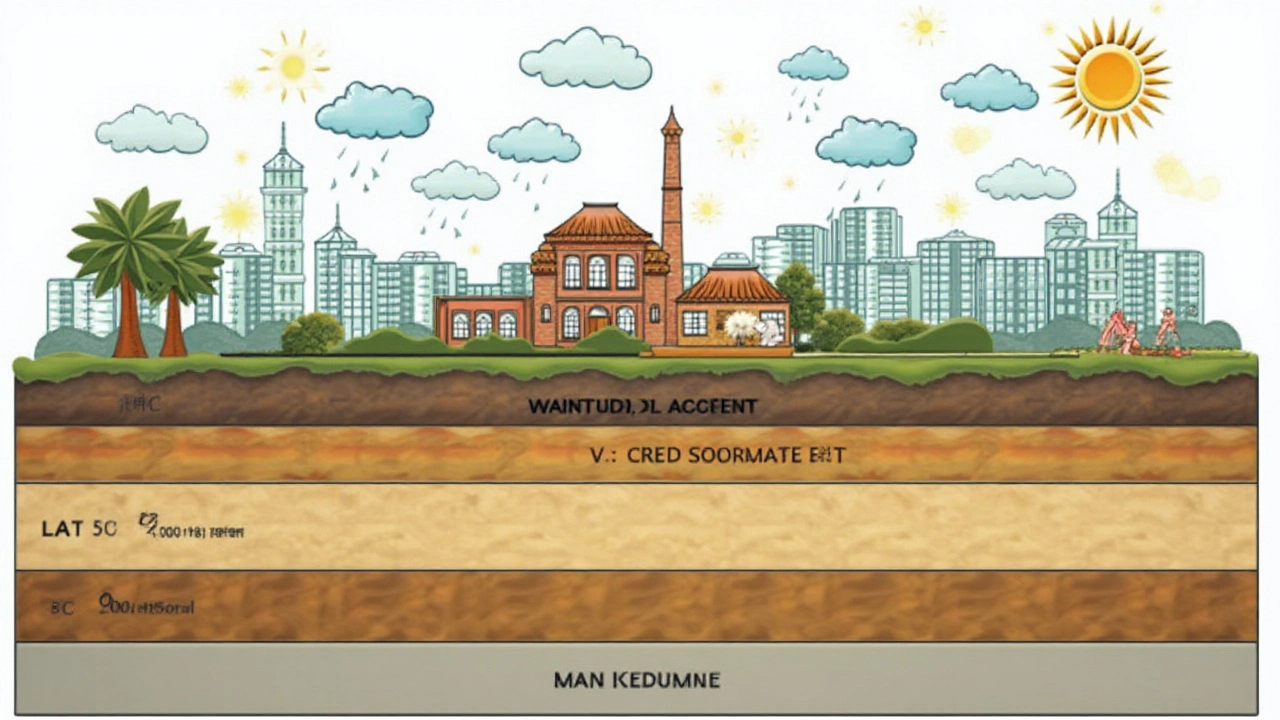Foundation repair is no small feat and at the heart of it lies a significant player: cement. Getting this choice right can be the difference between a lasting repair and a short-lived fix. As seasoned homeowners or eager DIY enthusiasts, understanding the nuances of cement types for foundation repair can arm you with the knowledge to tackle cracks and structural issues effectively.
Diversified in their composition and purposes, cements used for foundation repairs have distinct characteristics. This means there's no one-size-fits-all answer, but rather a spectrum of options optimized for different scenarios. So, let's dive into everything you need to know to keep your home standing tall and stable.
- Understanding Foundation Repair Needs
- Types of Cement for Foundation Repair
- Factors to Consider When Choosing Cement
- Common Challenges in Foundation Repair
- Expert Tips for Successful Cement Use
Understanding Foundation Repair Needs
When it comes to maintaining the sanctity of a home's structure, the importance of its foundation can never be overstated. The foundation serves as the backbone, providing support and strength to the entire building. However, over time, and under various environmental influences, even the most robust foundations may show signs of wear and tear. It's crucial to understand how these needs arise and the methods to address them efficiently.
The necessity for foundation repair often hinges on several factors. Natural elements such as soil erosion, excess moisture from poor drainage, and the effects of earthquakes or other geological phenomena can lead to significant shifts in the foundation over time. These shifts may not be immediately visible, but gradually they manifest as cracks in walls, uneven flooring, or doors and windows refusing to close properly. Identifying these subtle signs early can save both time and money in repairs.
"A house is only as strong as its foundation, and neglecting its repair needs is like ignoring a leaky roof during a rainstorm." — Anonymous
There's also the human element to consider. Modern construction practices sometimes fall short, especially when cost-cutting takes precedence over quality. Inferior materials or rushed construction jobs can leave even new homes vulnerable to foundational issues. That's why understanding the condition and construction quality of your foundation at the outset can provide insights into potential vulnerabilities and guide timely interventions.
In tackling the complexities of foundation repair, homeowners must ask essential questions: What specific type of damage is present? Is it simply cosmetic or indicative of deeper structural issues? Assessing these needs accurately often requires professional evaluation. Engineers and contractors can use specialized tools to gauge the severity of damage accurately, suggesting appropriate remedies that cater precisely to the home's foundation needs.
Once the type and extent of damage are known, selection of suitable repair materials, such as the right cement for foundation repair, becomes critical. Cement choice highly depends on environmental conditions, the particular issues faced, and other variables like the age of the structure. Each situation demands a tailored approach to ensure that repairs not only address immediate issues but also extend the foundation's lifespan.
Addressing the foundational concerns is only part of the journey. Equally important is understanding the root causes precisely to prevent recurrence. For instance, managing drainage effectively can avert moisture-related issues. This proactive strategy supports the efficacy of repair efforts by addressing groundwater and erosion impacts head-on.
Types of Cement for Foundation Repair
When diving into the realm of foundation repair, the choice of cement can dictate the success or failure of your project. One of the most ubiquitous types is Portland Cement. It's a well-loved staple in construction due to its versatility and strength. Originating from limestone and clay, this cement offers a reliable setting time, making it ideal for many repair jobs. Its adaptability allows it to be mixed and used in varied climates, which, given the diverse weather conditions here in New Zealand, is a significant advantage.
Another essential type is Hydraulic Cement, which is particularly celebrated for its ability to set and harden quickly even when submerged in water. This makes it a go-to for stopping water leaks and is an invaluable asset in foundation repairs, especially when dealing with basements or underground constructions. The cement's reaction with water triggers expansion, forming a tight seal that's impermeable to moisture. In fact, the rapidly growing popularity of this cement is backed by a fascinating study from the Journal of Materials in Civil Engineering, which highlights its superior adhesion properties in challenging conditions.
For those tackling smaller repairs, Non-shrink Grout is the cornerstone cement product. Designed to be used where space is constrained or where a smooth finish is paramount, this cement doesn't contract upon drying, maintaining volume and offering a lasting solution. It's particularly effective in patching by addressing cracks and gaps. Its innate attributes make it a sought-after choice by many DIY enthusiasts looking for a straightforward application.
"Choosing the correct cement type isn't merely about strength, it's about appropriateness for the specific conditions," emphasizes Julia Dennison, a renowned structural engineer.
Moreover, there are instances where Polymer-Modified Cement takes the spotlight. Enriched with polymers, this type provides additional flexibility and a higher degree of bonding capability, making it ideal for environments where slight movement might be anticipated. By incorporating polymers, these cements handle stress better, ensuring that repairs stand the test of time.
The essential takeaway here is that while there are several options available, understanding the specific needs of your foundation and the attributes of each type of cement is crucial. Whether it's the quick-setting prowess of Hydraulic Cement or the expansive properties of Non-shrink Grout, choosing the right option can steer your foundation repairs towards success. Remember to consult with professionals or do meticulous research before making a decision—it’s an investment in your property’s future stability.

Factors to Consider When Choosing Cement
Choosing the right cement for foundation repair is a decision that involves several critical factors. To start, one must consider the regional climate and environmental conditions. Different varieties of cement react differently to moisture levels, temperature fluctuations, and even soil composition. For instance, in a humid environment, a cement with high water resistance is beneficial. Adapting to climatic conditions ensures the longevity of your repair work. But this is just the tip of the iceberg when it comes to making an informed choice.
Another aspect to note is the specific type of damage that requires repair. Cracks, for example, necessitate a different approach than foundational shifting does. Crack repairs usually benefit from hydraulic cements due to their rapid setting nature and expansive properties, which help in filling gaps thoroughly. On the other hand, larger structural concerns may demand a more robust solution like a high-strength Portland cement mix, known for its rigidity and bearing capacity. According to a study in the Journal of Materials in Civil Engineering, "proper material selection is critical to addressing distinct foundation issues, each requiring specialized chemical and physical characteristics."
You should also prioritize the strength requirements of the project. This involves understanding both the initial set time and the ultimate compressive strength the material will achieve once cured. Fast-setting cements might appeal for their convenience but can compromise structural integrity if not matched well with the needs of the repair. Considering the soil's bearing capacity and how a new cement formulation might react can also guide your choice. Consult local building codes or guidelines as these often dictate specific standards for certain types of construction projects.
Beyond physical and technical characteristics, it's wise to consider the long-term economic implications. The initial cost of a particular cement type might not immediately indicate its cost-effectiveness. For instance, materials that are cheaper up front might invite recurring repairs due to inadequate match with the foundation conditions, leading to higher expenditures over time. Engaging with professionals who understand geographical nuances can provide invaluable insight, potentially saving both time and money by recommending the most effective cement foundation repair solution upfront.
An often overlooked but equally important consideration is the environmental impact of your choice. As sustainability becomes increasingly necessary, opting for eco-friendly cement types that have lower carbon footprints, like those with supplementary cementitious materials, can make a considerable difference. These alternatives not only align with sustainable practices but often deliver favorable results in terms of durability. According to the Environmental Protection Agency, making such mindful choices can contribute significantly to reducing overall environmental impact in construction.
Ultimately, selecting the right cement requires a detail-oriented approach that weighs various factors against the background of practical and geographical demands. It’s a blend of understanding material properties, recognizing the nuances of particular issues, and aligning with economic and environmental objectives. By taking a holistic view, you ensure that the foundation, the very bedrock of any structure, is sound and steadfast for years to come.
Common Challenges in Foundation Repair
Tackling foundation repair is no walk in the park. There are layers of difficulty that can surprise even the most seasoned professional or committed DIY enthusiast. One of the initial challenges lies in correctly diagnosing the root cause of foundation issues. It's not just about spotting a crack and filling it with cement. Identifying whether problems stem from soil movement, water intrusion, or poor construction can drastically change the approach and materials required, like the type of cement foundation repair best suited for the task.
Another major hurdle is dealing with unpredictable soil conditions. Soil composition, moisture levels, and temperature fluctuations can significantly impact how foundation repairs are executed. Some soils, such as clay, expand and contract dramatically with moisture changes, putting stress on foundation materials. Concrete, including some best cement for foundation repairs, can resist such pressure but might require specific formulations or additives. As the saying goes, "A strong foundation begins with understanding the soil beneath," highlighting the importance of thorough site assessment.
A challenge not to be underestimated is the disruption that foundation repair can cause to daily life. Strong vibrations from machinery, noise from construction, and the simple fact of having work crews on site can be quite unsettling for residents. Planning around these disruptions is crucial, particularly when the repair site is a home or a business. Balancing the technical aspects of choosing appropriate foundation repair materials with the practical realities of construction can be difficult. It requires careful choreography to ensure that disruptions are minimized while maintaining repair quality.
Weather conditions also play a pivotal role in foundation repair work. Rain, snow, or even extreme heat can severely impact timelines and material performance, especially for cement types which require certain conditions to cure properly. For instance, water can interfere with curing, leading to weaker structures if not managed carefully. Projects may be delayed by weather-related issues, requiring flexibility and advanced planning to mitigate these risks. As concrete expert Bradley Turnham once remarked, "Adapting to environmental challenges is as vital as the material you choose," which underscores the importance of preparedness.

Expert Tips for Successful Cement Use
Using cement effectively for foundation repair is as much an art as it is a science. The right techniques and tools can make the difference between a durable fix and one that fails prematurely. Let's delve deeper into some practical tips that can guide you through the process. The basics start with understanding the specific needs of your repair project. For small cracks, a simple cement patch might suffice, while larger, structural issues may require a blend that accommodates more robust functionality.
Begin by evaluating the environmental conditions you're dealing with. For example, areas with frequent freeze-thaw cycles will benefit from using air-entrained cement, which is designed to resist such stresses. Climate plays a significant role—warm, humid environments can accelerate the curing process, potentially impacting the strength and stability of the completed repair. A pro tip from industry experts suggests that you should always have a detailed understanding of the specific batch requirements, factoring in temperature and humidity, to ensure the cement sets correctly.
Mixing is another critical step often underappreciated in the foundation repair fixation process. Correct proportions of cement, sand, and water must be maintained to achieve the desired strength. Overly waterlogged mixtures can weaken the cement, reducing its load-bearing capacity. Conversely, a mix with too little water may not set properly or bond well with existing structures. Many professionals recommend a ratio of one part cement to two parts sand, seasoned with water until the mix achieves a pasty consistency. Always avoid adding too much water, as this not only dilutes the mixture but can also lead to shrinkage cracks as it cures.
"The secret to robust cement mixes is in the environment—know it inside out," advises J. Hamilton, a respected structural engineer.
Attention to detail doesn't end with mixing. Application techniques are pivotal to cement's performance. Ensure the surface you are applying the cement to is clean and free of debris. A wire brush can be employed for cleaning out cracks, while a damp sponge or sprayer can moisten surfaces just before application, ensuring the best possible bond. After applying, careful curing of the cement is essential. Keep the surface moist for several days after application to prevent it from drying too quickly—this slows the drying process and contributes to a stronger end product.
Lastly, don't forget safety. As often as the hands-on work might seem fun, it demands protective gear. Always wear gloves and goggles to protect yourself from dust and splashes. Consider using a mask if you're working in a confined space where dust could become problematic. Legal and environmental regulations are also crucial, particularly the disposal of unused cement and rinsing tools in non-polluting manners. Missteps in these areas can lead to fines or damaging consequences to local ecosystems.

Written by Fletcher Abernathy
View all posts by: Fletcher Abernathy